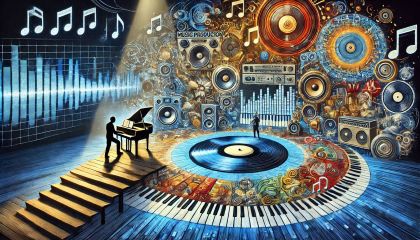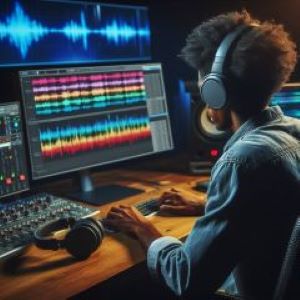This article explores the fascinating evolution of music production from its analog roots to the digital revolution, highlighting key developments, technological advancements, and the implications for artists and producers. It examines the blend of analog warmth with digital accessibility, traces contemporary innovations, and speculates on the future landscape of music production.
Music is the heartbeat of humanity, a universal language that transcends cultures, languages, and time itself. It can evoke joy, sorrow, nostalgia, and even the urge to dance like nobody’s watching—unless, of course, you’re in a crowded subway. Since the dawn of time, humans have been creating music, but the way we produce it has evolved dramatically. So, grab your headphones, and let’s dive into the fascinating journey of music production from the analog warmth of yesteryear to the crisp precision of today’s digital landscape.
The Analog Era: A Symphony of Shadows
Back in the day, music production was a bit like baking with your grandmother—there were no precise measurements, and a pinch of this or a dash of that could change everything. The analog era of music, which began in the early 20th century, was characterized by the use of physical media—like vinyl, tapes, or reels—to capture sound. Imagine a world where music was not just a download away but lovingly crafted and committed to tape, full of warm imperfections that added character to every note.
The Birth of Recording Technology
The journey began in the late 1800s with the invention of the phonograph by Thomas Edison. This beautiful contraption used a mechanical stylus to engrave sound vibrations onto a cylinder. From there, we saw the birth of the gramophone, which allowed music to be played back via a needle on a disc. Early recording artists faced a myriad of challenges: poor sound quality, limited recording time, and the necessity of perfecting their craft in one take. Talk about putting the pressure on!
Fast forward to the mid-20th century, and we saw the emergence of magnetic tape, which allowed for multi-track recording. Suddenly, producers could lay down multiple instruments at once or build a sonic masterpiece track by track. This was the golden age of record production, where the likes of Phil Spector created the wall of sound, and musicians like The Beatles pushed the boundaries of what was possible in the studio—a laboratory of creative experimentation.
The Beauty and Brilliance of Analog
There’s an undeniable warmth to analog recordings. That vinyl crackle and the gentle hiss of tape give music a unique soul. Many artists and producers still swear by analog equipment today, claiming it adds depth and texture to their sound. There’s something magical about sitting in a dimly lit studio, surrounded by vintage synthesizers and reel-to-reel machines, creating music that’s as rich as a double chocolate cake.
However, as glorious as the analog world was, it came with its quirks: limited editing capabilities, the need for technical expertise, and a price tag that could make your wallet weep. The painstaking process of splicing tapes and adjusting levels meant that music production was often akin to alchemy—an art form that not everyone could master.
The Digital Revolution: A New Era of Sound
By the late 20th century, technology began making strides faster than a caffeinated rabbit. The introduction of digital recording technologies changed the music landscape forever. Imagine getting to be a kid in a candy store where everything is bright, shiny, and ready to be explored—this was the digital revolution in music production.
The Rise of Digital Audio Workstations (DAWs)
In the 1980s, Digital Audio Workstations (DAWs) entered the scene, providing musicians with multi-track recording, editing, and mixing capabilities that were not only revolutionary but also user-friendly. Suddenly, anyone with a computer could become a producer. Programs like Pro Tools, Logic Pro, and Ableton Live became essential tools for artists, transforming bedrooms into world-class studios.
Now, musicians could record, edit, and manipulate sound in ways that were previously unimaginable. Want to extend that guitar solo? No problem! Need to pitch-correct your vocals? Easy peasy! The barriers to entry were fading fast, allowing a new generation of creators to rise. This opened the floodgates for creativity, giving birth to genres like electronic music, hip-hop, and pop that might have struggled to gain traction in the analog era.
Accessibility and Collaboration: A Global Sound
The digital transformation brought unprecedented accessibility, allowing aspiring musicians from all corners of the globe to create and share their work. Platforms like SoundCloud and Bandcamp enabled artists to distribute their music without the need for traditional record labels. Collaboration became a breeze; you could now team up with a producer across the globe as easily as sending a text.
With technology continuously advancing, tools like virtual instruments and plugins became the new toys in the sonic playground. The sonic palette expanded; you could create anything from lush orchestral pieces to gritty hip-hop beats, all without ever leaving your chair—or wearing pants, for that matter.
Hold on to your hats, because along came foolproof pitch correction tools like Auto-Tune, adding a spark of controversy into the mix. It became both a beloved tool and a polarizing subject among musicians and purists alike. The discussion around pitch correction often resembles a classic debate over which pizza topping reigns supreme—there’s passion, but truthfully, it’s all delicious!
The Winds of Change: New Challenges and Opportunities
While digital music production has democratized the art form, it also ushered in a wave of challenges. With the convenience of access comes an overwhelming sea of content. There’s a proverbial goldmine of music available, but standing out in this ocean can feel like trying to find a needle in a haystack—while blindfolded.
Additionally, the debate over analog vs. digital continues, with purists lamenting the loss of warmth and character in a world dominated by zeros and ones. Many producers still chase that analog sound through various means, whether it’s using vintage hardware, reamping through analog gear, or employing clever post-processing techniques. There’s a collective quest for authenticity in a sea of digital perfection.
The Future of Music Production: A Blended Approach
As we march boldly toward the future, the line between analog and digital continues to blur. The rise of hybrid studios, where artists utilize both analog gear and digital tools, showcases a creative renaissance. It’s like the best of both worlds—think peanut butter and chocolate or a perfectly crafted mix tape that never quits giving.
Additionally, emerging technologies like artificial intelligence are starting to play significant roles in music production. AI can analyze trends, assist with mixing, and even produce music that sounds remarkably human. This opens up a whole new realm of possibilities but also raises questions about creativity and authorship. Is a hit song generated by AI in the same league as a heartfelt ballad by a human? Now that’s a conversation starter worthy of a late-night jam session!
Conclusion: Music As An Ever-Evolving Artform
As the curtain falls on this exploration of music production, it’s clear that the journey from analog to digital is a story of perseverance, creativity, and passion. Music, much like a fine wine, only gets better with age—and innovation. While analog may charm us with its warmth and character, the digital age offers accessibility, endless possibilities, and a stage for voices that would otherwise remain unheard.
Whether you’re a vinyl collector or a bedroom producer, one thing is for certain: the evolution of music production reflects the ever-changing landscape of human expression. So, as we listen to our playlists—old and new—let’s celebrate the artists, engineers, and the tools that have shaped our sonic experiences. After all, the music never really stops; it just keeps evolving, bending time, sculpting emotions, and reminding us why we fell in love with it in the first place.




